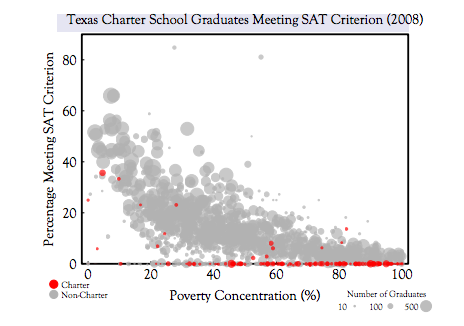Texas public schools were intended to be open to all students. Many upscale charter schools operate much the same as exclusive private schools. In theory they are open but, unfortunately, operators have devised various methods to control entrance in these schools. Some, in fact, charge fees. Oftentimes in interviews parents are asked what they can do for the charter school if their children are admitted. Those parents who promise the most have their children admitted first. In other cases charter schools require essays which are not necessarily graded on an objective basis and these results are used as the basis of admission.
Charter schools are authorized by the state -- but they are in fact private schools. Most them are entirely funded by the allotment they receive per student out of funds allocated by the Legislature for public education in the state. In fact, on the average, charter schools receive more money per pupil than the average public school. Charter schools receive $5,746 for each student enrolled, while your public school receives $5,708.
Charter schools are not regulated by the state and do not require certified teachers. Recent studies show they spend more on administration and less on instruction than do traditional or public schools. There is no regulation or control on how much charter schools may choose to pay their owners or operators. Generally, owners and operators are the same people who give themselves titles of principals or superintendents. In at least one charter school I am aware of, the owner/operator paid herself over $200,000 a year to run a single-school operation. This particular charter school is located within a school district of several thousand students wherein the superintendent receives slightly over $200,000 a year -- as the head of all the public schools in a large district.
 |
| Illustration published here featuring a report by Dr. Michael Marder, Professor, The Univ of Texas. |
While there are several advocates for expanding the charter school phenomenon in Texas it is generally resisted by teacher groups, as well as by associations of school trustees and administrators. There is an odd mix of political attitudes opposing expansion of charter schools in the Legislature. It is usually a combination of minority representatives and rural representatives. In the current session of the Legislature, the fact that the past legislative session cut funding for public education by over $5 billion has thrown cold water, for the most part, on the current attempts to expand charter schools. Even so, there is legislation authored by some elected officials which requires that some properties paid for by taxpayers be given or leased to charter schools for a nominal amount of $1 a year.
There are numerous other differences between public schools and charter schools. For example, charter schools are not required to meet the federal guidelines on free lunches or entrance requirements. I have often said charter schools simply remind me of families on a tight budget with numerous children who then choose to adopt others, even though they cannot afford the ones they have naturally.
Public taxpayers should keep an eye on the status of legislative funding of charter schools by simply calling them private schools.
[Editor's Note: In spite of the fact that charters may have admissions requirements, an interesting report and charts like the one above by University of Texas professor Dr. Michael Marder show that public high school students consistently outperform charter school students on SAT/ACT tests. Want a good short explanation in words and pictures? See the chart above and others comparing Texas public high schools and Texas charter high schools in a short movie narrated by Dr. Marder here, and an EdWeek blog article here.]
